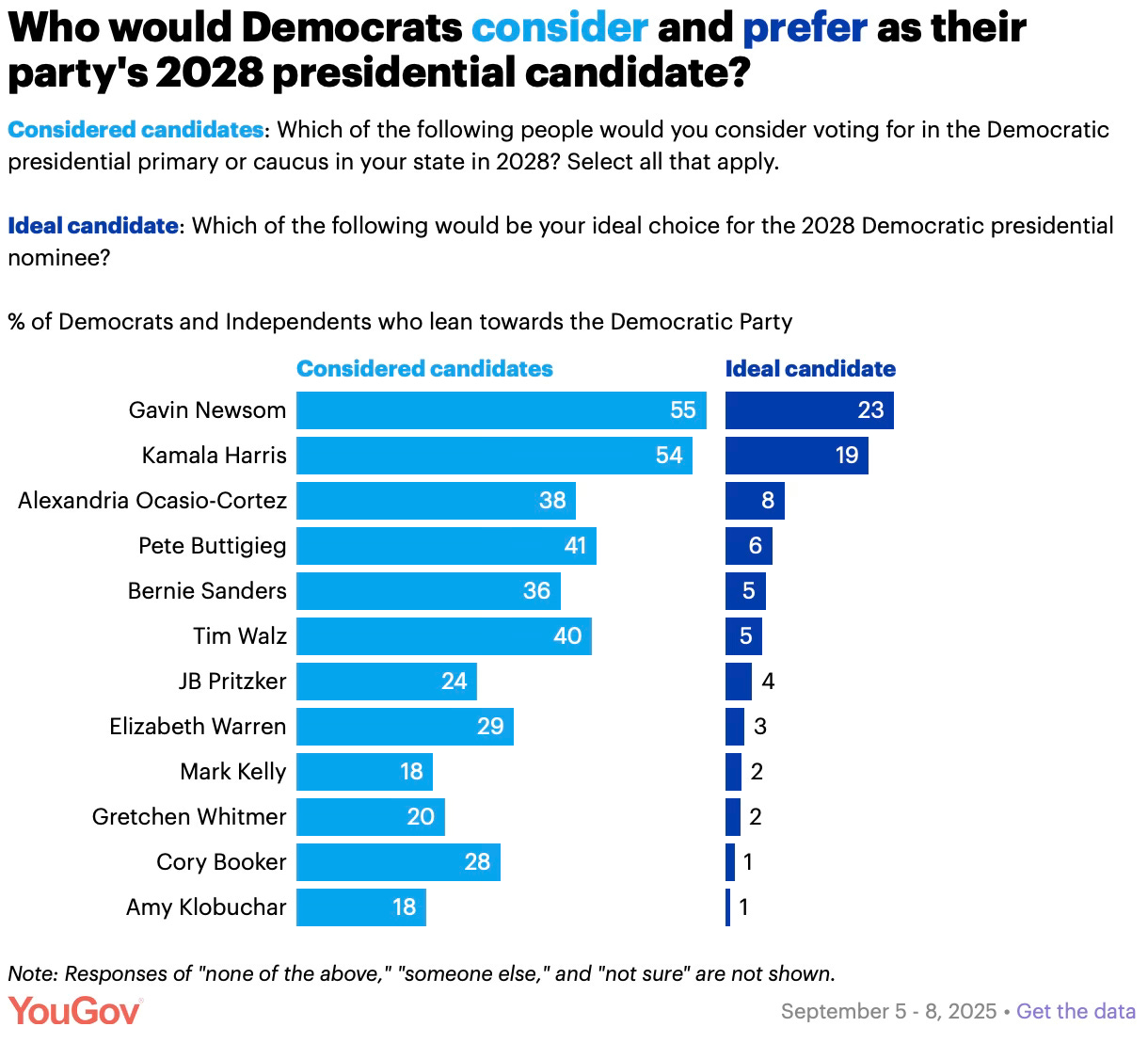Gavin Newsom Is the Early Democratic Frontrunner for a Reason
The party’s two main factions won’t accept the other side dominating. The “Resistance” will likely emerge as the winner.
It’s never too early for premature speculation about the presidential election three years away! In all seriousness, although the Democratic Party’s candidate pool has not been determined—some strategists say it could be as high as 20 candidates—we can examine the internal dynamics of the party as it exists today to see which direction it might be heading.
On this front, the idea that one of the two main party factions, the progressives and the centrists (for lack of more precise terms), will vanquish the other in the 2028 presidential primary process seems fanciful.
The progressive faction, with down-the-line economic, social, and foreign policy leftism, does not impress many mainstream Democrats who aren’t particularly active in the media or online. Whether it’s AOC, Ro Khanna, Chris Murphy, or someone else who heads the left front, the progressives’ vague denunciations of the billionaire class coupled with radical cultural positions on immigration, crime, and gender issues plus non-stop “anti-Zionist” agitation appeal mostly to an ideologically contained cohort of younger, more urban Democrats from the Bernie Sanders/Elizabeth Warren wing of the party. Despite being totally enamored with their own policy vision, “full progressivism” is not an agenda widely supported by other “normie” Democrats—or other Americans.
Conversely, the centrist faction, with its “abundance” economic model and often indeterminate social and foreign policy views that amount to “heterodoxy” or “common sense,” may have appeal among the larger American electorate, but unfortunately, may have less appeal to many Democratic primary voters. So good centrist candidates like Josh Shapiro, Andy Beshear, Rahm Emanuel, or someone else with arguably wider reach in the Electoral College will face stiff odds among the primary voting base. Joe Biden’s nomination as the centrist alternative in 2020 only came together after an extraordinary bit of cooperation by the other moderate-lane candidates to drop out, while Sanders and Warren split the leftist vote. That seems unlikely to happen this time around, particularly since the existing establishment alternative, Kamala Harris, may face serious distrust from Democrats since she blew the last election and has been loath to accept any responsibility for it since then.
So, if neither the left nor the center can dominate the other, this leaves one of two possibilities: (1) an anti-establishment insurgent or party outsider emerges from either faction to win the hearts and minds of Democrats (as Barack Obama did in 2008), or (2) Democratic voters forego both factions and go for a strong anti-Trump “Resistance” figure as a compromise.
Enter, Gavin Newsom. Few Democrats have been as successful as Newsom at gleefully challenging Trump and Vance while simultaneously rallying hardcore Democrats on redistricting and trying to reach out to audiences like younger men that the party has lost over the past few cycles.
Now, all the pollsters and strategists will tell you Newsom is an electoral disaster-in-waiting as the governor of deep-blue California with its myriad economic and social problems, from high housing costs to uncontrolled homelessness and crime. But Newsom makes total sense when you consider the more important internal party dynamic that each ideological faction will only accept a candidate who clearly represents their own positioning. Newsom is the political equivalent of the Rorschach test—he’s whatever you want him to be, and the only thing that matters is that he’s willing to “fight” Trump and Vance. Or as he quipped to Politico about the Democratic Party’s factional divide, “I want it to be the Manchin to Mamdani party.”
This branding probably explains why he’s atop the list of people that Democrats say they will consider voting for in 2028, according to recent YouGov data:
Newsom’s standing has risen significantly since similar questions were asked on the Economist/YouGov Poll in April. The share of Democrats and Democratic-leaning independents who say they would consider voting for him as the Democratic nominee in 2028 has risen 24 percentage points, to 55 percent from 31 percent. The share who say Newsom is their ideal candidate has increased 16 points, to 23 percent from 7 percent.
Of course, there are other potential “Resistance” alternatives to Newsom in the form of lesser-known governors such as JB Pritzker in Illinois and Wes Moore in Maryland or former presidential candidate Pete Buttigieg who could fill this role should Democratic voters look disapprovingly upon Newsom (and Harris fails to rehabilitate herself within the party).
The political logic is the same regardless of who the eventual person ends up being. Democrats are too splintered internally to accept the dominance of either the progressive faction or the centrist faction. The winner therefore will likely be a non-factional figure who is younger and capable of making a sharp case against the Trump administration with a platform that offers just enough to everyone in the party to keep them focused on who and what they dislike the most.
The “Resistance” for the W!





Assuming you are right (it’s early but you make a good case) — is Newsom a transformative candidate who can quell the clamoring demands and herd the cats? Or is he just another compromise candidate — just enough progressive, just enough liberal, a little bit of country and a little bit of rock and roll?
If the former, he may do well. If the latter, that often falls flat I think.
J D Vance is the next president of the U S
! Outside chance is Rubio ! Cruz : nope!
!